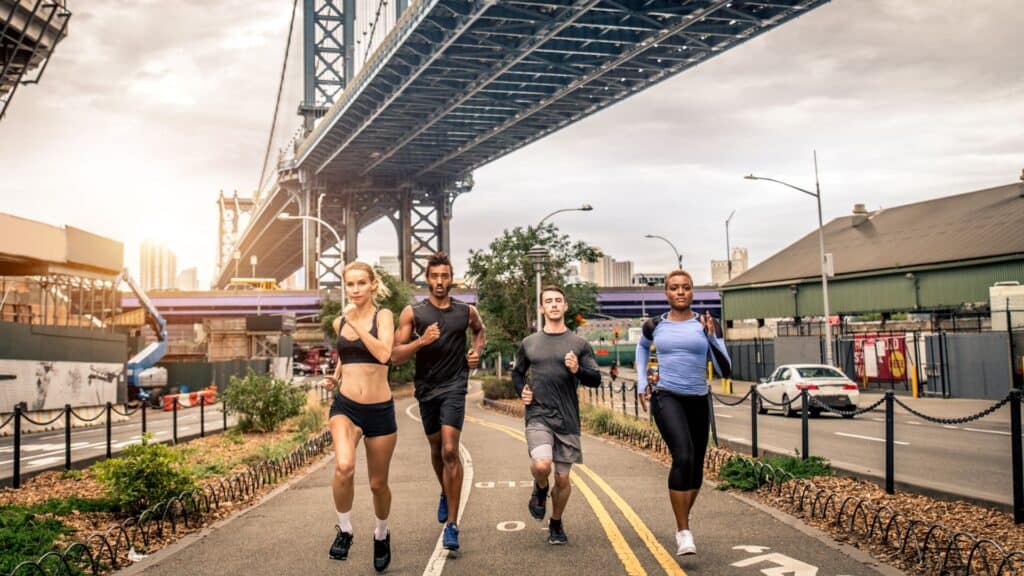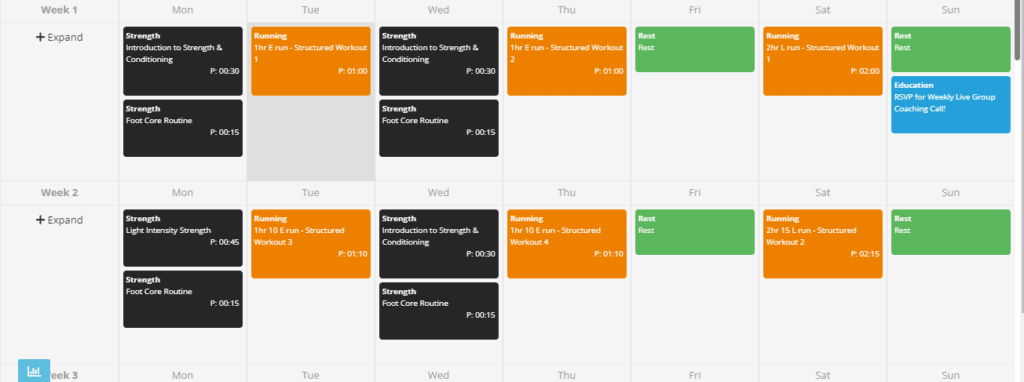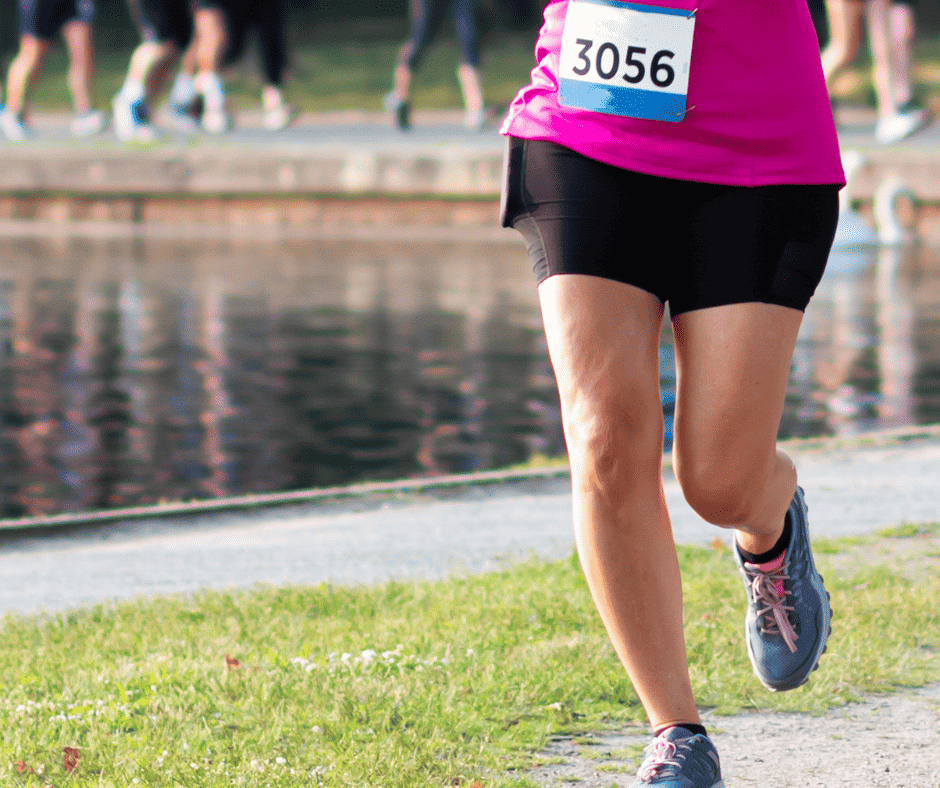You’ve decided to go from ‘couch to New York City Marathon’‘… This is going to be an adventure you’re never going to forget.
Running through all five boroughs of New York City, including Brooklyn, Queens, the Bronx, and Manhattan before finishing in Central Park might just be the start of your running obsession which will lead you to set the goal to tick other marathons around the world off the list.
New York City Marathon was my first marathon, and while I had done some other events before this, it has to be THE BEST marathon experience I have had to date.
With the right training principles, mindset, and guidance, it is possible to go from being a beginner runner with minimal to no experience to running and completing the New York City Marathon within 365 days.
In this article, we are going to walk you through our Couch to New York City Marathon training method, as well as everything you need to know as a beginner taking on this incredible challenge.
Let’s begin!

Understanding What Fitness Level You Are At & How To Get To Where You Need To Be
All runners have to start somewhere…
Marathon training can start no matter your ability or background. There’s no one size fits all approach.
If you’ve never run before, 26.2 miles can look like an impossible distance—but, you’re reading this article and that’s a great place to start!
For the sake of this article, we are going to assume you are at the ‘couch’ level… Meaning, a beginner, where perhaps you have not even run a 5k yet.
We are going to break down your couch to New York City Marathon training into achievable milestones.
This will prevent you from taking on too much too soon and keep you motivated right up until you cross that finish line.
Let’s have a look at how long it’s going to take you to achieve each of the milestones…
How Long Does It Take To Train For Couch To The New York City Marathon?
Consistency is the name of the game here… If you stick to the steps, build up at the correct pace, and give yourself time to enjoy the journey without any injuries, you can go from couch to running the New York City Marathon in exactly 48 weeks.
Let’s break those 48 weeks up into achievable stages…
- 0 to 5km = 12 weeks
- 5 to 10km = 12 weeks
- 10 to 21km = 12 weeks
- 21 to 42km = 12 weeks
By looking at the training plans below, you’ll see how the 5km,10km, and 21km are important milestones on your journey to running the New York City Marathon.
If you follow each of the training plans consecutively, it’ll take you just under 1 year to get marathon-ready.
Click here to get access to The Couch to New York City Marathon Training Roadmap!
On that note, let’s have a look at what the training will look like…
What Your Couch To New York City Marathon Training Will Look Like
The key to going from couch to New York City Marathon is to build up your endurance safely and efficiently so that you avoid any running injuries along the way.
The best way to do that is to follow a training program that is specific to you, your age, gender, and ability.
Training programs like the one we offer will gradually increase your mileage efficiently and safely so that you don’t have to worry about how long you need to run on which days.
The same is for the training plans that we are going to go through below…
The paces you are required to run may feel like they are too slow but the goal is to get you to run EASY as this will allow you to adapt without risking injury.
It is important to adhere to all the principles in this program to ensure success:
• Doing strength training is critical to reducing the risk of injury.
• Consistency. Keep ticking off sessions, taking it day by day, and watch how you blossom over the coming weeks.
It is very important to stick to your training paces, training faster will feel good but it will work against everything we are trying to achieve.
Making sure you do the correct strength training is important. The good news is we’ve created a free strength training plan for runners that you can download by clicking here.
A Sneak Peek at What Your Couch to NYC Marathon Training Plans Will Look Like


Easy Training Runs
Easy training runs help you add weekly volume to your running plan. By easy we mean EASY. You should be able to hold a conversation with someone next to you and not be struggling to get a breath in at the same time. If you run on your own you should be able to burst into song without getting out of breath
There will always be easy runs in the plan. Depending on level/ability more so that stage of training
Rest Days
Rest days are as important as your training days. They and, allow you to adapt to your training. Rest days are important to allow the body time to adapt to the training you are putting it through.
Runners don’t realize when they start running that they only get the benefits from the exercise they are doing when they are resting and not doing the exercise.
You only adapt and get stronger for your run training after your training when you are resting and when your body is recovering.
With our, training plans we structure your rest days to maximize recovery so that you have a guarantee that you can fit in all your training and the rest days required on the correct days.
Consistency is important… Even when it comes to rest. Start to think of your rest days the same way you would as a run day or a strength day, as important as a session.
Allowing yourself time to recover after your runs is what makes it possible for you to come back better adapted for your next run. Here is a Practical Guide To Running Recovery.
Strength Training
Strength training that is specific to runners is vital, for two main reasons. The first is for injury prevention, and the second is to improve your running performance and make you a faster and more efficient runner.
Strength training plays an integral part in the Coach Parry training philosophy and that’s why we’re including our S&C plans as part of the training program.
We know you can get strength training anywhere, google is full of it.
It’s not just about the plan but how you implement it. The technique is vital and we place a huge focus on technique in our strength and conditioning classes.
It’s also important that you are doing strength training that is specific to running and will help prevent running injuries.
Read more about the importance of strength training here.

Long Runs
Long runs are a vital key to you completing the New York City Marathon.
The purpose of a long run is to achieve several different outcomes, the most important outcome of the long run is your base endurance or building your endurance. This is your body’s ability to provide energy across the spectrum of distances.
The long run also plays an important role in improving the running economy when we are training for longer distances.
Long runs teach us to be on our feet for a long time and they physiologically prepare us for going longer distances. We suggest that people experiment with different nutrition on long runs so that they can see what works best for race day. One of the biggest mistakes I see new runners making is not fueling for the exercise they are doing! They are doing all the right training but without the fuel, won’t get anywhere
Let’s have a look at some achievable goals you should set for yourself…
Setting Couch To Marathon Goals (5Km, 10KM, 21KM)
The 5k to 10k, 10k to a half marathon, and half marathon to marathon stages should be treated as separate stages and separate goals.
You can adjust your time goals as you get further into the plans and once you see your results.
If you use our training plans we include a time trial every four weeks so that you can track your progress.
Feel free to pause between training plans as well if that’s what your body is telling you to do.
For example, if you do the ‘Couch to 5k’ training plan, you don’t immediately have to jump straight into the ‘5k to 10k’ training plan. Just remember to maintain your fitness levels by walking, hiking, or doing other cross-training exercises.
Don’t jump from one plan to the next too quickly if you’re not feeling ready; take the time to rest, and consolidate your new running fitness, before moving forward.
Always listen to your body through this process. This becomes key because if you push through niggling pains they can become chronic injuries. That means less consistent running which is what we don’t want.
We need to set realistic goals for where we are now and not where we want to be.
For example… I want to (and know I can) run a Sub3h40 marathon in time but if I train at that pace now I will be training above where I am currently and I risk injury as well as won’t be training in the correct training zones for where I am at the moment.
The Training Plans You Need To Go From Couch To New York City Marathon
View all of the training plans we have discussed above here!
All of these training plans include:
Daily Training Sessions:
– Every training session is broken down into exactly what you need to do
– There are pacing guidelines for every run so that you know exactly how fast to run them; with videos from the coaches talking you through what is expected in the session.
– The correct amount of recovery is included to make sure you benefit from a combination of easy runs and interval training (depending on your ability) based on a polarised model of training (ie 80/20 principle).
– Know exactly when and how long your long training runs should be.
Strength Training:
– There are plans for all abilities so if you’ve never done Strength training or a master, we’ve got you covered.
– We place a huge focus on technique in these classes to help reduce your risk of injury and to ensure that you are working the correct muscles.
– Mobility and static stretching plans are also included.
– No need to go to a gym or buy expensive equipment. Everything can be done at home.
Big Picture Planning:
– See how each training session fits into the overall New York City Marathon Training Roadmap
– Analyse your training data within the plan so that you can see how you are responding to the overall training
What you do leading up to the New York City Marathon will either set you up for success or failure…
Ensure your success with the Coach Parry Couch to New York City Marathon Training Roadmap.

Beginner Tips To Go From Couch To New York City Marathon
- Start with a good pair of running shoes.
- Stay motivated: Set achievable goals, track your progress, and find a running community to support you.
- Cross-train.
- Get more sleep.
- Run your easy runs easy.
- Eat a balanced diet and experiment with different foods during your training to find what works best for you during training and during the marathon. (Running Nutrition: 8 CRUCIAL Nutrition Tips You Need To Know)
- Include running-specific strength training to avoid injuries and to help with running performance.
- Study the course, and familiarize yourself with the route, including bridges and hills, to better prepare for the race. Route Guide Here.
- Fall in love with the process and I can promise you, you will have an unforgettable day in New York City.



Comments are closed.